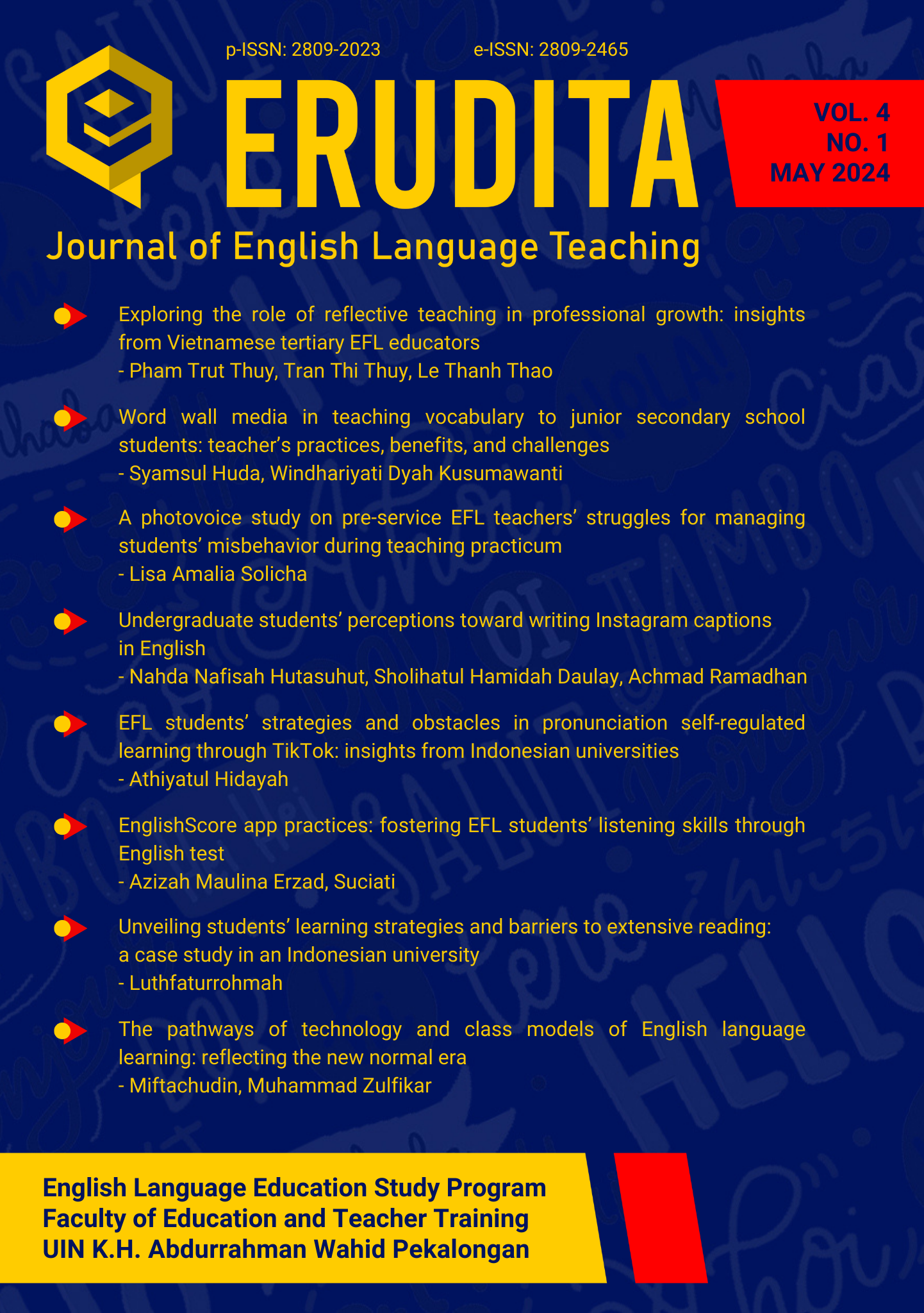EFL students’ strategies and obstacles in pronunciation self-regulated learning through TikTok: insights from Indonesian universities
DOI:
https://doi.org/10.28918/erudita.v4i1.8366Keywords:
English pronunciation, Self-regulated learning, TikTokAbstract
Self-regulated learning (SRL) is crucial for mastering English pronunciation, specifically for an autonomous learning environment, including TikTok application. The present study aims to explore students’ experiences while practicing English pronunciation using TikTok as self-regulated learning. This study was designed with a qualitative case study approach. The researcher used reflection sheets and semi-structured interviews to garner data. Data were analyzed employing an interactive model. The selected participants in this research were university EFL students who learned pronunciation via TikTok. The research findings reported that the students used metacognitive strategy for independent planning, knowledge, and problem-solving for learning difficulties. Motivational strategy was also pivotal in learning pronunciation and maintaining motivation. Likewise, behavioral strategy was carried out for practicing process and shaping a conducive environment to learning activities. Nonetheless, several obstacles were encountered by the students, including lack of immediate feedback, unstructured content, low motivation, and distractions during learning. Low motivation and distraction were considered the main obstacles, which made pronunciation one of the most difficult language components in the context of SRL. This study provides practical implications for how TikTok application benefits students’ pronunciation skills, especially in self-regulated learning.
References
Amini, D., Anhari, M. H., Ghasemzadeh, A., & Tarnopolsky, O. (2020). Modeling the relationship between metacognitive strategy awareness, self-regulation and reading proficiency of Iranian EFL learners. Cogent Education, 7(1). https://doi.org/10.1080/2331186X.2020.1787018
Annur, C. M. (2023, February 01). Survei KIC-Kominfo: Pengguna TikTok di Indonesia meroket tajam semenjak pandemi Covid-19 [KIC-Kominfo survey: TikTok users in Indonesia have skyrocketed since the Covid-19 pandemic]. Databoks. https://databoks.katadata.co.id/datapublish/2023/02/01/survei-kic-kominfo-pengguna-tiktok-di-indonesia-meroket-tajam-semenjak-pandemi-covid-19
Bahri, A., Damayanti, C. M., Sirait, Y. H., & Alfarisy, F. (2022). Aplikasi TikTok sebagai media pembelajaran bahasa Inggris di Indonesia [TikTok as a medium for learning English in Indonesia]. Jurnal Indonesia Sosial Sains, 3(01), 120–130. https://doi.org/10.59141/jiss.v3i01.525
Bashori, M., van Hout, R., Strik, H., & Cucchiarini, C. (2022). ‘Look, I can speak correctly’: Learning vocabulary and pronunciation through websites equipped with automatic speech recognition technology. Computer Assisted Language Learning, 37(5–6), 1335–1363. https://doi.org/10.1080/09588221.2022.2080230
Brady, A. C., Kim, Y. eun, & Cutshall, J. (2021). The what, why, and how of distractions from a self-regulated learning perspective. Journal of College Reading and Learning, 51(2), 153–172. https://doi.org/10.1080/10790195.2020.1867671
Brenner, C. A. Self-regulated learning, self-determination theory and teacher candidates’ development of competency-based teaching practices. Smart Learning Environment, 9(3). https://doi.org/10.1186/s40561-021-00184-5
Canani, M., & Zulli, T. (2022). ELT and social media: Integrating TikTok into class practice. MediAzioni, 34(1), 165–183. https://doi.org/10.6092/issn.1974-4382/15555
Creswell, J. W. (2012). Educational research: Planning, conducting, and evaluating quantitative and qualitative research (4th ed.). Pearson.
Dhea, D. A. N. (2023). The effect of TikTok video in learning pronunciation skill. Journal of English Language and Literature Teaching, 8(2), 465–469. https://ejurnal.unima.ac.id/index.php/jellt/article/view/6822
Fanaqi, C., Ismira, F. R., & Mustika, P. R. (2022). Pemanfaatan TikTok sebagai media edukasi di masa pandemi COVID-19 [Utilizing TikTok as an educational media during the COVID-19 pandemic]. Jurnal Komunikasi Universitas Garut, 8(2), 910–924. http://dx.doi.org/10.52434/jk.v8i2.2102
Faridah, D., Friatin, L. Y., & Rohayati, D. (2022). Optimizing students’ self-regulated learning through English pronunciation application in learning pronunciation during pandemic era. JALL (Journal of Applied Linguistics and Literacy), 6(2), 49–63. https://jurnal.unigal.ac.id/jall/article/view/8252
Fauziah, A. (2008). Teach pronunciation by using audio lingual method (A case study at fifth year students of SDN Bidaracina 01 Pagi Jakarta Timur) [Undergraduate Thesis, Universitas Islam Negeri Syarif Hidayatullah Jakarta]. Universitas Islam Negeri Syarif Hidayatullah Jakarta Repository. https://repository.uinjkt.ac.id/dspace/handle/123456789/28201
Fitria, T. N. (2023). Value engagement of TikTok: A review of TikTok as learning media for language learners in pronunciation skill. EBONY: Journal of English Language Teaching, Linguistics, and Literature, 3(2), 91–108. https://doi.org/10.37304/ebony.v3i2.9605
Lai, Y., Saab, N. & Admiraal, W. (2022). Learning strategies in self-directed language learning using mobile technology in higher education: A systematic scoping review. Education and Information Technology, 27, 7749–7780. https://doi.org/10.1007/s10639-022-10945-5
Lukes, L. A., Jones, J. P., & McConnell, D. A. (2020). Self-regulated learning: Overview and potential future directions in geoscience. Journal of Geoscience Education, 69(1), 14–26. https://doi.org/10.1080/10899995.2020.1820828
Martin, H., Craigwell, R., & Ramjarrie, K. (2021). Grit, motivational belief, self-regulated learning (SRL), and academic achievement of civil engineering students. European Journal of Engineering Education, 47(4), 535–557. https://doi.org/10.1080/03043797.2021.2021861
Masaki, F. (2023). Self-regulation from the sociocultural perspective—A literature review. Cogent Education, 10(2). https://doi.org/10.1080/2331186X.2023.2243763
Miles, M. B., Huberman, A. M., & Saldana, J. (2014). Qualitative data analysis: A methods Sourcebook. SAGE.
O’Donnell, N., Jerin, S. I., & Mu, D. (2023). Using TikTok to educate, influence, or inspire? A content analysis of health-related EduTok Videos. Journal of Health Communication, 28(8), 539–551. https://doi.org/10.1080/10810730.2023.2234866
Oladipupo, R., & Akinola, A. (2022). Nigerian English pronunciation preferences: A corpus-based survey of pronunciation variants. Cogent Arts & Humanities, 9(1). https://doi.org/10.1080/23311983.2022.2061104
Prashant, P. D. (2018). Importance of pronunciation in English language communication. Research Papers in Economics, 7(2), 15–20. https://ideas.repec.org/p/vor/issues/2018-27-05.html
Sholikhi, F. (2023). Learning English through YouTube videos to foster speaking skills: Public Administration students’ perceptions. Erudita: Journal of English Language Teaching, 3(1), 68–80. https://doi.org/10.28918/erudita.v3i1.6996
Sperling, R. A., Howard, B. C., Staley, R., & DuBois, N. (2004). Metacognition and self-regulated learning constructs. Educational Research and Evaluation, 10(2), 117–139. https://doi.org/10.1076/edre.10.2.117.27905
Turan, S., Demirel, Ö., & Sayek, İ. (2009). Metacognitive awareness and self-regulated learning skills of medical students in different medical curricula. Medical Teacher, 31(10), 477–483. https://doi.org/10.3109/01421590903193521
Downloads
Published
How to Cite
Issue
Section
License
Copyright (c) 2024 Athiyatul Hidayah

This work is licensed under a Creative Commons Attribution-ShareAlike 4.0 International License.















